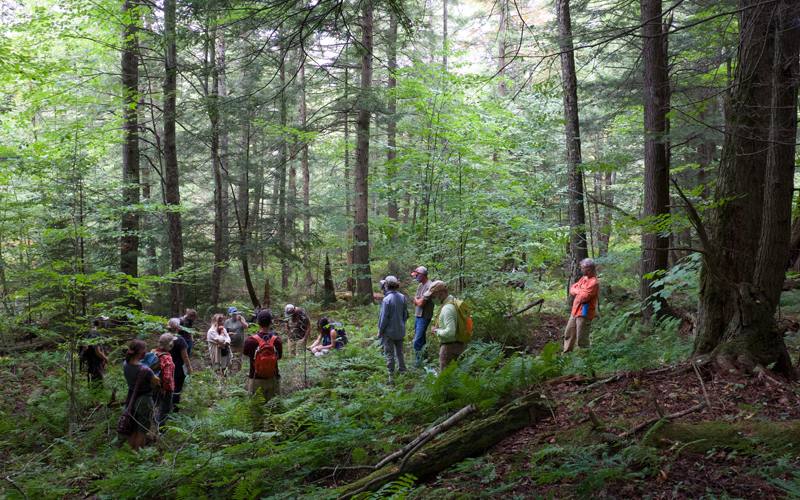This fall, during a moderate drought and a local lull in the coronavirus pandemic, 16 Vermont Master Naturalist students gathered by the Mad River to plant trees. Under a September sun, the first cohort of Vermont Master Naturalists carried saplings to the flood plain of the Austin parcel, shook their root balls loose and planted them in bare ground where a thicket of Japanese knotweed once stood. The buttonbush went in the wet swale by the river, the boxelder on the sandy berm above.
The Vermont Master Naturalist Program (VMN) was developed in 2016 by Burlington field naturalist Alicia Daniel, who has taught field ecology for over 30 years using a landscape-level approach to help UVM students interpret natural history. The program has expanded into 18 towns in Vermont, with the first Mad River Valley chapter kicking off in June 2020. The VMN goal is to equip Vermont residents with the tools needed to understand the layers of their landscape -- from bedrock to birds -- and empower them to take conservation action in their communities.
The field day at the Austin parcel was an embodiment of the VMN mission: Before planting, the group walked down to the Cobble River Shore, a habitat type scoured by floods and home to rare tiger beetles. They discussed the processes that shape flood plains and the effects of nonnative plants on local ecology, and then applied their new knowledge to the restoration site above.
FIELD TRIPS
Since June, the Mad River Valley VMN cohort has met three other times for daylong field trips, beginning with a glacial geology tour of The Valley led by geomorphologists Craig Heindel and Kristen Underwood. A natural community workshop took them to the hemlock forests and swamps of Wu Ledges, and they explored historic hill farms in the overgrown cellar holes of Little River State Park with Daniel and ecologist Sean Beckett. (For a VMN virtual tour of Little River State Park visit go to: https://www.youtube.com/watch?v=QhXrpEz-aJY.) Winter curriculum will include winter trees and mammal tracking, and next spring will bring a workshop on wildflowers and their pollinators as well as a hike to an old-growth forest stand.
And while many group members reported feeling isolated during the pandemic, VMN is providing participants with an added benefit: connection. Participant Jeannie Nicklas said, “As well as paying more attention to the flora and fauna that I’ve been introduced to, I’m enjoying the interactions with new and old friends who share the same passions.”
Along with group camaraderie, participants gain a more intimate connection to their home place. “The program is designed to orient people to their home landscapes,” said Daniel.
For participant Paul Sipple, Fayston, finding a woodland seep in a little-traveled corner of Wu Ledges Town Forest was an eye-opening moment: “Just the fact that we have these subtleties on the landscape -- we need to protect those.”
AUSTIN PARCEL
Along with field outings, VMN participants work on local conservation, education and stewardship projects. The Austin parcel restoration project was just one project on the list of local offerings, which included a cultural history exploration of Fayston’s newly-acquired town forest sponsored by the Fayston Conservation Commission, educating people about the value for biodiversity of planting native plants sponsored by Vermont Alliance for Half-Earth and an ecological assessment of a patch of subalpine old-growth forest sponsored by the Warren Conservation Commission. “They get a menu of conservation work going on in their towns,” Daniel said. “And the long-term success with these projects lies in the fact that people stay involved. They join the conservation commission; they continue to plant trees.”
This conservation momentum is what motivated Curt Lindberg, VMN Mad River Valley program coordinator, to help bring the program to The Valley. “Our goal is to develop a broader conservation ethic in this special place and to equip more residents with a deeper understanding of the nature around us and what we can do to treasure and preserve it,” he said.
In the weeks following planting day, many of the Vermont Master Naturalists returned to the Austin parcel to check on the flood plain’s new cohort of native shrubs and trees. As the drought stretched on, some watered the plants with their own bottles. Local walkers paused on the path to remark on the restoration work, which is part of ongoing stewardship of the flood plain by the Waitsfield Conservation Commission, Friends of the Mad River, Mad River Path Association and Intervale Conservation Nursery.
As Vermonters seek refuge in the natural world as an elixir for 2020, the VMN projects provide residents of the Mad River Valley with the opportunity to give back to their home place. As Sipple says, reflecting on the first half of the program, “It’s made me a better citizen, a better Vermonter.”
For more information about Vermont Master Naturalist visit https://vermontmasternaturalist.org/. Contact Lindberg (






